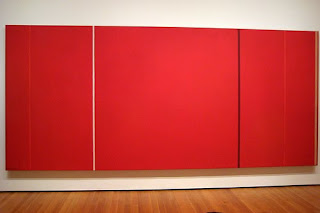
Image of Ocean Park No. 24, Oil on Canvas by Richard Diebenkorn
"It wasn't
art that I was interested in; it was drawing and painting...I had no real understanding of drawing and painting as art."- Richard Diebenkorn
For a man that was interested in art he most certainly acquired some kind of understanding of it because throughout Diebenkorn's life he became one of the most influential American Abstract Expressionists. Diebenkorn was born in Portland Oregon on April 22, 1922, his family relocated to San Francisco two years after that. Although is parents were not particularly supportive of his interest in the arts, Diebenkorn found encouragement in his grandmother, who fostered his visual imagination by giving him illustrated books, taking him to local galleries and impressing upon him a love for European heraldic imagery.
Diebenkorn disappointed his parents by choosing art as his major for his undergraduate studies at Stanford University in 1940. There he met Daniel Mendolowitz, one of his art history professors and mentors who introduced the aspiring painter to the work of modernists such as Henri Matisse and Edward Hopper, whose works would prove formative to Diebenkorn's artistic development. Diebenkorn married in 1943 and enlisted into the U.S. Marine Corps directly after, serving for two years. The young artist then returned to California and used his GI Bill to enroll in the California School of Fine Arts, and soon became a faculty member a year after. In the 1950s, Diebenkorn pursued his Master of Fine Arts degree at the University of New Mexico. Throughout the 1950s he moved between across the nation gaining inspiration from it all. While in the Southwest in acquired the use of bright planes of color in organic shapes and borrowed techniques from New York.
Diebenkorn was such a talent, but this only came from many years of study. He was truly influenced by Clyfford Still, Arshile Gorky, Willem De Kooning, Mark Rothko, and Edward Hopper. He was also inspired by some critics of the time- David Park and Daniel Mendelowitz. Another thing the pushed Diebenkorn in an international spotlight was his involvement in the San Fransisco-Bay Area School artists. Many of the artists involved were those who were mentioned above-his influences.
Richard Diebenkorn achiecved a rare feat in the life of an artist, which is to approach painting from many different angles and to take earnest inspiration from other artists while maintaining originality. Although Diebenkorn did not reach the level of fame of Abstract Expressionists of the New York School, his influence on artists of the latter half of the 20th century is undeniable.
Image of Diebenkorn in the 1950s
Information From:
A Concise History of American Painting and Sculpture by Matthew Baigell
www.theartstory.org/artist-diebenkorn-richard.htm Article written by Kara Fiedorek
Images From:
wallpapers-free.co.uk
www.theartstory.org
 Franz Kline, who is best known for his work in black and white, was one of many abstract expressionists of his time, exhibiting in the Eagan Gallery in 1950. He was largely effected by artists such as Jackson Pollock through their works and through his friendship with Willem de Kooning. Later in his career, he managed to incorporate color as effectively as his forte, black and white.
Franz Kline, who is best known for his work in black and white, was one of many abstract expressionists of his time, exhibiting in the Eagan Gallery in 1950. He was largely effected by artists such as Jackson Pollock through their works and through his friendship with Willem de Kooning. Later in his career, he managed to incorporate color as effectively as his forte, black and white.









